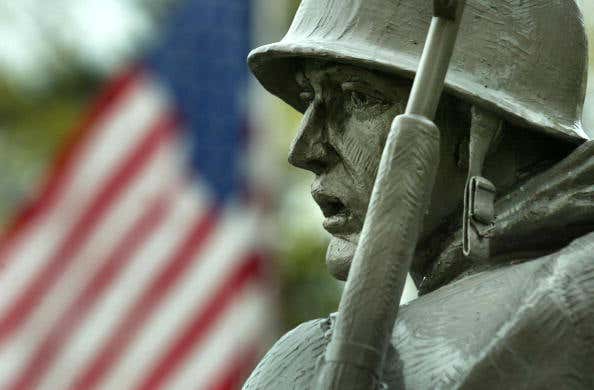
In America, we value the men and women who were willing to risk it all for our freedoms and enlist in the military. But this wasn’t always the case.
On September 3, 1783, the United States minted its first veterans and promptly cheated them. Yes, our early vets got hosed. At the end of the Revolutionary War, the Continental Army discharged its soldiers and disbanded, sending its vets home with the uniforms on their backs, a signed paper discharge and an IOU.
At the beginning of the war, Congress had promised land, pay, and even pensions to its recruits. After years of fighting, though, the government was too busted to offer more than a promissory note, hence the IOU. Some returning soldiers were so broke they sold their notes for immediate cash just to get home, getting far less than the face value. For the rest, the IOUs lost value in the struggling post-war economy, making the promised money worth less. Veterans were forced to choose between waiting for their notes to reach full value, which could take years, or selling them at a reduced value for immediate cash.
Soon, veterans and the general public were clamoring for relief from the government; they wanted the military to receive pensions. It wasn’t until 1818 that Congress and Revolutionary War Veteran and President James Monroe passed the first veterans’ pension legislation for enlisted men. That’s thirty-five years after the war’s end. By then, many had died, and those still alive to collect had to prove they served at least nine months in the Continental Army or Navy and were in “reduced circumstances.” Even though the veterans of the state militias or men who served for a short term were excluded, and those who were not impoverished weren’t eligible, some 20,000 vets did apply. So many that Congress added a new requirement in 1820, applicants had to list all their possessions to prove they were needy enough.
Finally, in 1832, forty-nine years after the war’s end, Congress passed the first pension act that provided a yearly sum to every man who had served for six months or more, regardless of economic status, health, or branch of military service. Widows who were married to soldiers during the war were also eligible for a pension if they could prove their wedding date.
Over the years, over 80,000 people, including male and female soldiers, widows and one widower, applied for pensions. Many applications were rejected due to missing discharge papers, proof of service or marriage records. Even worse, many veterans of African descent and Native Americans were often rejected by judges who didn’t find them as deserving as white men.
At least some soldiers were able to collect.
The last known Revolutionary War veterans died shortly after the Civil War. The last pension for a widow of a Revolutionary War veteran was paid in 1906, 123 years after the war had ended.
So, if they weren’t being paid, were monuments going up in every town?
While the Continental Congress authorized the first national Revolutionary War memorial in 1776, honoring Brigadier General Richard Montgomery, it wasn’t until 1799 that the first monument to the soldiers of the war was dedicated. The Lexington‘s Revolutionary War Monument, erected fifteen years after the end of the war it commemorated, honored the local soldiers who had died defending the town against the British Regulars in 1775.
Funded by the Commonwealth of Massachusetts, the column was designed by stone cutter Thomas Park at a cost of $400.00. On April 20, 1835, the 60th anniversary of the Battles of Concord and Lexington, all but one of the eight men honored on the monument were exhumed from Lexington’s Old Burying Ground and reinterred beneath the monument with full military honors. Despite bad weather, nearly 1,000 people, including eleven survivors of the battle, attended the ceremony to listen a two-hour speech by the Honorable Edward Everett, in “breathless silence.”
So, were we now honoring our Veterans with public ceremonies to recognize our veterans’ sacrifices?
Not on a national level. While many communities would dedicate a day to gather its veterans for photos, parades and cemetery services, the Veteran’s Day Federal holiday is just 70 years old. Its roots are traced to a day dedicated to reflection and remembrance of a war, not its veterans.
Planning a Veterans Day celebration? You can download the history of Veterans Day, a gallery of Veterans Day posters and a colorful and informative Veterans Day Teacher’s Resource Guide here.
In 1921, on November 11th at 11:00 AM, an unknown World War I American soldier was buried in Arlington National Cemetery. Its timing honored the ending of the ‘Great War’s’ fighting in 1918 at the 11th hour of the 11th day of the 11th month. Five years later Congress recognized this date as Armistice Day and it would become a national holiday in the hope that it commemorated the end of “the War to end all wars.”
Just a few years later, however, war broke out in Europe and eventually sixteen and a half million Americans would serve in World War II. At the end of the war the US had more than 16 million veterans among its citizens.
The first celebration calling itself Veterans Day came in 1947 in Birmingham, Alabama, when Raymond Weeks, himself a World War II veteran, organized a "National Veterans Day," with a parade and other activities to honor all veterans. The movement caught on, and in 1954, President Dwight Eisenhower signed a bill proclaiming November 11 as Veterans Day. In 1982, Mr. Weeks received the Presidential Citizens Medal for his contributions.
Yet even this recognition would be negotiable. In 1968, The Uniform Holiday Bill was signed, moving Veterans Day to the closest Monday – to allow federal a guaranteed fourth 3-day weekend each year. The other three? Washington’s Birthday, Memorial Day, and Columbus Day. In 1978, President Gerald Ford signed an order moving it back to its original date on November 11, where we celebrate it today!





